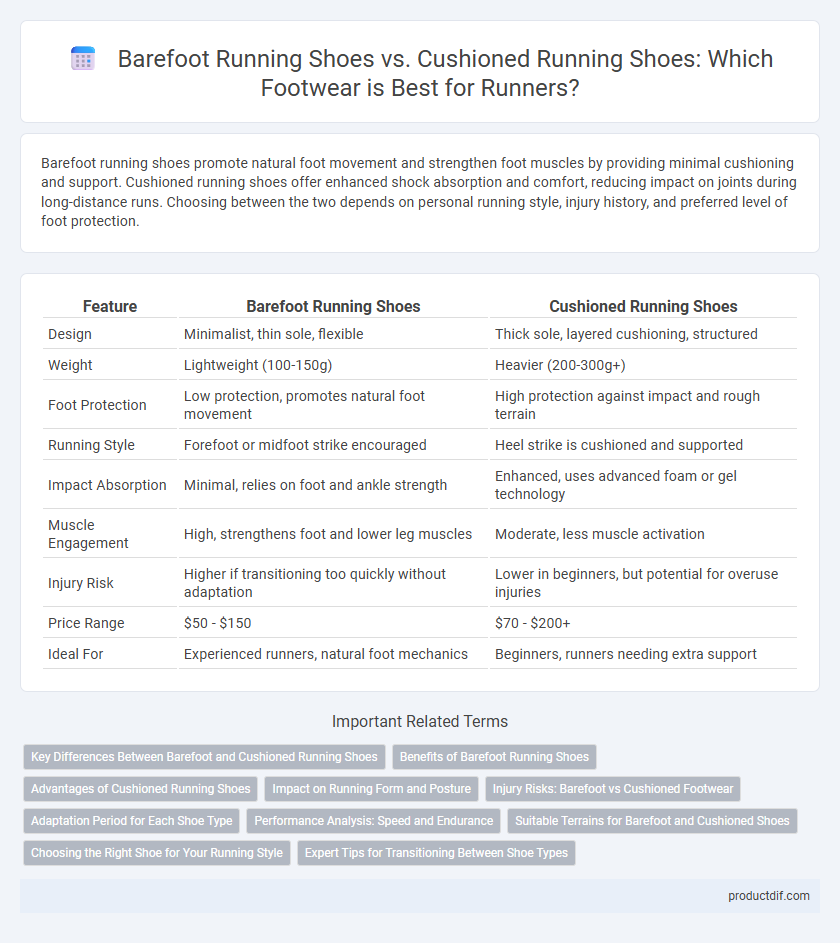Barefoot running shoes promote natural foot movement and strengthen foot muscles by providing minimal cushioning and support. Cushioned running shoes offer enhanced shock absorption and comfort, reducing impact on joints during long-distance runs. Choosing between the two depends on personal running style, injury history, and preferred level of foot protection.
Table of Comparison
| Feature | Barefoot Running Shoes | Cushioned Running Shoes |
|---|---|---|
| Design | Minimalist, thin sole, flexible | Thick sole, layered cushioning, structured |
| Weight | Lightweight (100-150g) | Heavier (200-300g+) |
| Foot Protection | Low protection, promotes natural foot movement | High protection against impact and rough terrain |
| Running Style | Forefoot or midfoot strike encouraged | Heel strike is cushioned and supported |
| Impact Absorption | Minimal, relies on foot and ankle strength | Enhanced, uses advanced foam or gel technology |
| Muscle Engagement | High, strengthens foot and lower leg muscles | Moderate, less muscle activation |
| Injury Risk | Higher if transitioning too quickly without adaptation | Lower in beginners, but potential for overuse injuries |
| Price Range | $50 - $150 | $70 - $200+ |
| Ideal For | Experienced runners, natural foot mechanics | Beginners, runners needing extra support |
Key Differences Between Barefoot and Cushioned Running Shoes
Barefoot running shoes feature minimal padding and a thin sole to allow natural foot movement and ground sensation, promoting a more natural running form. Cushioned running shoes have thick midsoles made from EVA or gel materials to absorb impact and provide enhanced shock absorption, reducing strain on joints. Key differences include sole thickness, heel-to-toe drop, and overall weight, where barefoot shoes favor flexibility and lightweight design while cushioned shoes prioritize comfort and injury prevention.
Benefits of Barefoot Running Shoes
Barefoot running shoes enhance natural foot mechanics by promoting improved balance, stronger foot muscles, and a more efficient stride, reducing the risk of common running injuries. They allow runners to experience ground feedback and better terrain adaptability, leading to increased proprioception and agility. Lightweight and flexible designs encourage a forefoot or midfoot strike, minimizing impact forces on joints compared to cushioned running shoes.
Advantages of Cushioned Running Shoes
Cushioned running shoes provide enhanced shock absorption, reducing impact on joints and lowering the risk of injury during long-distance runs. Their structured support and padding improve comfort, particularly for runners with high arches or those who require additional stability. Advanced cushioning technologies also promote better energy return, helping to maintain endurance and performance over extended periods.
Impact on Running Form and Posture
Barefoot running shoes encourage a forefoot or midfoot strike, promoting a more natural running form and improved posture by reducing heel impact and enhancing proprioception. Cushioned running shoes, designed with thick midsoles and heel padding, tend to promote a heel-strike pattern that can increase joint stress and alter natural alignment. Choosing the right shoe impacts biomechanics, influencing stride efficiency, injury risk, and overall posture during running.
Injury Risks: Barefoot vs Cushioned Footwear
Barefoot running shoes promote a natural foot strike and can reduce impact forces but may increase the risk of cuts, bruises, and stress fractures for unconditioned runners. Cushioned running shoes provide shock absorption and support, lowering the risk of overuse injuries like plantar fasciitis and joint pain but can lead to altered gait mechanics and a higher risk of repetitive stress injuries. Choosing the appropriate footwear depends on individual biomechanics, running style, and injury history to minimize overall injury risks effectively.
Adaptation Period for Each Shoe Type
Barefoot running shoes require a longer adaptation period, often several weeks to months, as they emphasize natural foot mechanics and strengthen foot muscles by reducing heel cushioning. Cushioned running shoes allow for a shorter adaptation phase since they provide substantial support and shock absorption, minimizing immediate strain on joints and tendons. Gradual transition is essential for both types to prevent injury, with barefoot shoes demanding more careful progression to build endurance and flexibility.
Performance Analysis: Speed and Endurance
Barefoot running shoes enhance proprioception and promote a natural gait, potentially improving speed by encouraging a midfoot strike and reducing ground contact time. Cushioned running shoes provide superior shock absorption and energy return, supporting longer endurance by minimizing muscle fatigue and joint stress during prolonged runs. Performance analysis reveals barefoot shoes may benefit short bursts of speed, while cushioned shoes better sustain endurance over extended distances.
Suitable Terrains for Barefoot and Cushioned Shoes
Barefoot running shoes are best suited for smooth, natural terrains like grass, dirt trails, and sand, providing a ground-feel experience that enhances proprioception and promotes a natural gait. Cushioned running shoes excel on hard surfaces such as asphalt, concrete, and urban pavements, offering shock absorption and joint protection during long-distance runs. Choosing the appropriate footwear based on terrain optimizes performance, reduces injury risk, and supports running biomechanics effectively.
Choosing the Right Shoe for Your Running Style
Barefoot running shoes promote a natural stride by encouraging forefoot or midfoot strikes, reducing impact forces and strengthening foot muscles, making them ideal for runners seeking improved biomechanics and proprioception. Cushioned running shoes provide enhanced shock absorption and stability with thick midsoles and supportive features, benefiting runners who emphasize comfort and injury prevention, especially those with heel-strike patterns. Selecting the right shoe depends on individual biomechanics, running goals, and surface conditions, with gait analysis and gradual adaptation recommended to optimize performance and reduce injury risk.
Expert Tips for Transitioning Between Shoe Types
Transitioning from cushioned to barefoot running shoes requires a gradual adaptation period of at least 4-6 weeks to strengthen foot muscles and prevent injuries. Experts recommend starting with short runs and incorporating foot strengthening exercises such as toe curls and calf raises to build resilience. Monitoring running form by increasing cadence and landing midfoot can ease the transition and enhance overall running efficiency.
Barefoot running shoes vs Cushioned running shoes Infographic

 productdif.com
productdif.com